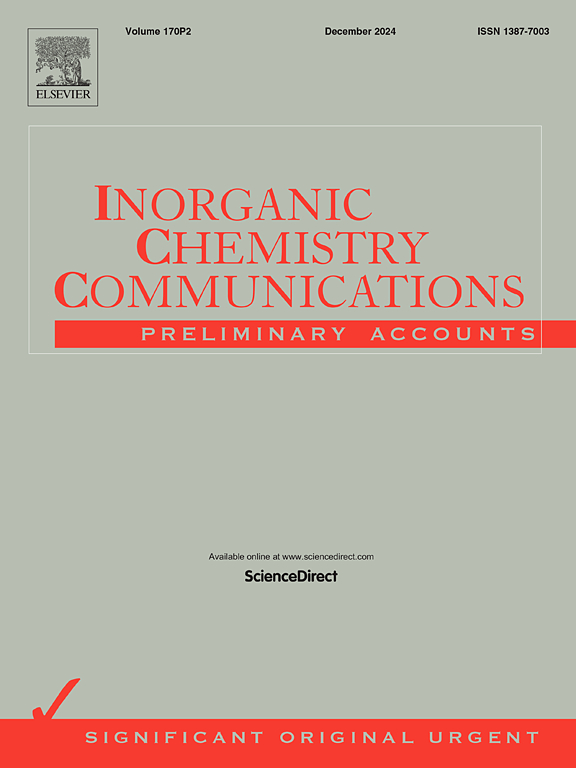揭示YAgCh2 (Ch = Se, Te)的光电和热电性质:第一性原理研究
IF 4.4
3区 化学
Q1 CHEMISTRY, INORGANIC & NUCLEAR
引用次数: 0
摘要
三元硫族化合物独特的结构和电子特性使它们成为能源应用的理想材料。在本研究中,我们使用密度泛函理论(DFT)计算来探索YAgSe2和YAgTe2材料的光电和热电特性。YAgSe2和YAgTe2的内聚能分别为- 4.57 eV/原子和- 4.76 eV/原子。这两种材料都没有表现出动力不稳定的迹象,因为没有虚模,这表明它们是热力学稳定的。基于它们的电子能带结构,这两种材料都显示出半导体特性,尽管YAgTe2比YAgSe2具有更窄的带隙,这使得它更适合红外吸收。可见和近红外区域具有较高的吸收系数,表明它们可以用作光电器件的吸收层。此外,确定了评价热电性能的重要热电参数。由于低晶格导热系数和良好的ZT,这两种材料都表现出潜在的热电效率,特别是在高温下。YAgSe2和YAgTe2的光学和热电特性的添加使它们成为太阳能转换和存储的材料选择。该研究强调了这些材料在可持续能源技术方面的潜力,并为理解其特征提供了广泛的理论框架。我们的研究结果为未来的实验探索和改进这些硫属化合物用于热电和太阳能应用指明了方向。本文章由计算机程序翻译,如有差异,请以英文原文为准。
Unveiling the optoelectronic and thermoelectric properties of YAgCh2 (Ch = Se, Te): First-principles study
Ternary chalcogenides’ unique structural and electronic properties have concentrated them as desirable materials for energy applications. In the present study, we used density functional theory (DFT) calculations to explore the optoelectronic and thermoelectric features of YAgSe2 and YAgTe2 materials. The cohesive energies for YAgSe2 and YAgTe2 were predicted to be −4.57 eV/atom and −4.76 eV/atom, respectively.. Both materials display no signs of dynamic instability, as indicated by the absence of imaginary modes, signifying that they are thermodynamically stable. Both materials show semiconducting properties, based on their electronic band structure, although YAgTe2 has a narrower band gap than YAgSe2, which renders it more suited for infrared absorption. The visible and near-infrared regions have high absorption coefficients, suggesting they could be used as absorber layers in optoelectronic devices. Furthermore, the important thermoelectric parameters are determined for evaluating thermoelectric performance. With low lattice thermal conductivity and favorable ZT, both materials exhibit potential thermoelectric efficiency, especially at high temperatures. The addition of YAgSe2 and YAgTe2′s optical and thermoelectric features makes them material choices for solar energy conversion and storage. The investigation highlights the potential of these materials for sustainable energy technologies and provides an extensive theoretical framework for comprehending their features. Our results suggest a direction for future experiments to explore and refine these chalcogenides for thermoelectric and solar applications.
求助全文
通过发布文献求助,成功后即可免费获取论文全文。
去求助
来源期刊

Inorganic Chemistry Communications
化学-无机化学与核化学
CiteScore
5.50
自引率
7.90%
发文量
1013
审稿时长
53 days
期刊介绍:
Launched in January 1998, Inorganic Chemistry Communications is an international journal dedicated to the rapid publication of short communications in the major areas of inorganic, organometallic and supramolecular chemistry. Topics include synthetic and reaction chemistry, kinetics and mechanisms of reactions, bioinorganic chemistry, photochemistry and the use of metal and organometallic compounds in stoichiometric and catalytic synthesis or organic compounds.
 求助内容:
求助内容: 应助结果提醒方式:
应助结果提醒方式:


